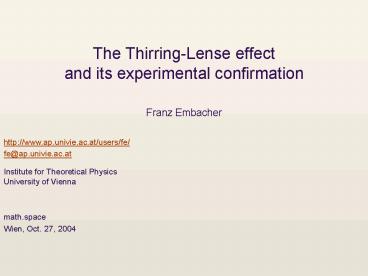The ThirringLense effect and its experimental confirmation PowerPoint PPT Presentation
1 / 23
Title: The ThirringLense effect and its experimental confirmation
1
The Thirring-Lense effectand its experimental
confirmation
- Franz Embacher
http//www.ap.univie.ac.at/users/fe/ fe_at_ap.univie.
ac.at Institute for Theoretical
PhysicsUniversity of Vienna math.space Wien,
Oct. 27, 2004
2
Isaac Newton, 1687
- Inertia is a phenomenon the relates the motion of
bodies to absolute space. - Rotation with respect to absolute space gives
rise to centrifugal forces, as illustrated by the
bucket experiment
3
Ernst Mach, 1883
- There is no absolute space.
- Inertia is a phenomenon the relates the motion of
bodies to the motion of all matter in the
universe (Machs Principle).
4
Ernst Mach, 1883
- A simultaneous rotation of all the matter in the
universe is unobservable. - The rotation of a part of the universe affects
the behaviour of inertial frames.
several miles thick
5
Machian effects
? The rotation of the earth should drag (local)
inertial frames.
w will later be called Thirring-Lense frequency.
6
Gyroscopes
More convenient than water buckets are
torque-free gyroscopes...
Dragging precession of gyroscope axes
7
Albert Einstein, 1915
- The general theory of relativity
- Gravity is identified with the geometry of
space-time. - Matter curves space-time.
- The free motion of a (small) body in a given
gravitational field is such that its proper time
is maximal.
8
Hans Thirring und Joseph Lense, 1918
- Newtonian gravity does not predict Machian
effects. - General relativity does
- H. Thirring Über die Wirkung rotierender ferner
Massen in der Einsteinschen GravitationstheorieP
hys. Zeitschr. 19, 33 (1918) - H. Thirring Berichtigung zu meiner Arbeit Über
die Wirkung rotierender ferner Massen in der
Einsteinschen GravitationstheoriePhys.
Zeitschr. 22, 19 (1921) - J. Lense und H. Thirring Über den Einfluss der
Eigenrotation der Zentralkörper auf die Bewegung
der Planeten und Monde nach der Einsteinschen
RelativitätstheoriePhys. Zeitschr. 19, 156
(1918)
9
Rotating matter shell interior region
- The interior of a rotating spherical matter shell
is (approximately) an inertial frame that is
dragged, i.e. rotates with respect to the
exterior region
10
Rotating matter shell exterior region
- Dragging effects outside the shell
11
Rotating planet or star
- Dragging effects near a massive rotating sphere
12
Satellite orbits
- Dragging of the orbital plane
Newtonian gravity
General relativity
13
Satellite orbits
- Magnitude of the effect
14
The role of Machian effects in general relativity
- Useful analogy that applies for stationary (weak)
gravitational fields - Newtonian part of the gravitational field ?
electric behaviour - Machian part of the gravitational field ?
magnetic behaviour - (sometimes called gravimagnetism)
1/r² attractive force
matter flow
Thirring-Lense frequency
Skip theory
15
Computation of Machian effects for weak fields
stationarity
electric component
magnetic components
Einsteins field equations
Geodesic equation
linearized theory
slow motion
Newtons potential
Thirring-Lense frequency
16
Rotating charge distribution/rotating matter
17
Does the Thirring-Lense effect exist in nature?
- George Pugh (1959), Leonard Schiff
(1960)Suggestion of a precision experiment
using a gyroscope in a satellite - I. Ciufolini, E. Pavlis, F. Chieppa, E.
Fernandes-Vieira and J. Perez-Mercader Test of
general relativity and measurement of the
Lense-Thirring effect with two Earch
satellitesScience, 279, 2100 (27 March
1998)Measurement of the orbital effect to 30
accuracy, using satellite data (preliminary
confirmation) - I. Ciufolini and E. C. Pavlis A confirmation of
the general relativistic prediction of the
Lense-Thirring effectNature, 431, 958 (21
October 2004)Confirmation of the orbital effect
to 6 accuracy, using satellite data - Gravity Probe B, 2005Expected confirmation of
gyroscope dragging to 1 accuracy
18
Ciufolini et. al., 1998
- 2 satellites LAGEOS (NASA, launched 1976)
andLAGEOS 2 (NASA ASI, launched 1992) - Original goal precise determinationof the
Earths gravitational field - Major semi-axes 12270 km, 12210
km - Excentricities 0.004 km, 0.014
- Diameter 60 cm, Mass 406 kg
- Position measurement by reflexionof laser
pulses(accurate up to some mm!) - Evaluation of 4 years position data
- Main difficulty deviations from spherical
symmetry of the Earths gravity field
LAGEOS 2
LAGEOS 2
LAGEOS
LAGEOS
19
Ciufolini et. al., 1998
- The perturbations by the shape of the Earth are
much larger than the expected dragging effect,
hence they must be taken into account!Model of
the Earths gravitational field EGM-96 - Further perturbations were accounted for
- Perturbation on the satellite motion by the
pressure of the sun light - Perturbation on the satellite motion by residual
air resistance - Variations of the Earths angular velocity
(tides!) - Variations in the positions of the poles
- Movement of the ground station by continental
drift - Gravitative perturbations induced by moon, sun
and planets - Clever choice of observables in order to
compensate for uncertainties in EGM-96 and to
separate Machian from Newtonian causes for
the precession of orbital planes
preliminary confirmation
20
Ciufolini et. al., 2004
- LAGEOS und LAGEOS 2
- Improved model of the Earthsgravitational
fieldEIGEN-GRACE02S - Evaluation of 11 years position data
- Improved choice of observables(combination of
the nodes of bothsatellites)
LAGEOS 2
LAGEOS
21
Gravity Probe B
- Satellite based experiment, NASA und Stanford
University - Goal direct measurement of the
dragging(precession) of gyroscopes axesby the
Thirring-Lense effect(Thirring-Schiff-effect) - 4 gyroscopes with quartz rotors theroundest
objects ever made! - Launch 20 April 2004
- Flight altitude 400 Meilen
- Orbital plane Earths center north pole IM
Pegasi (guide star)? Launch window 1 Second! - Proper motion of the guide star IM Pegasi 35
mas/yr - Same order as the Thirring-Lense-Effekt!
- Since 1997 measurements to 0.1 mas/yr accuracy
(using microwave VLBI by comparison with quasars
that lie nearby to the star on the sky)
22
Gravity Probe B
- Expectation for 2005 Measurement of the
Thirring-Lense frequency with an accuracy of
1 - Web site http//einstein.stanford.edu/
23
Thank you...
... for your attention! This presentation
may be found on the web under
http//www.ap.univie.ac.at/users/fe/Rel/Thirring-L
ense/

